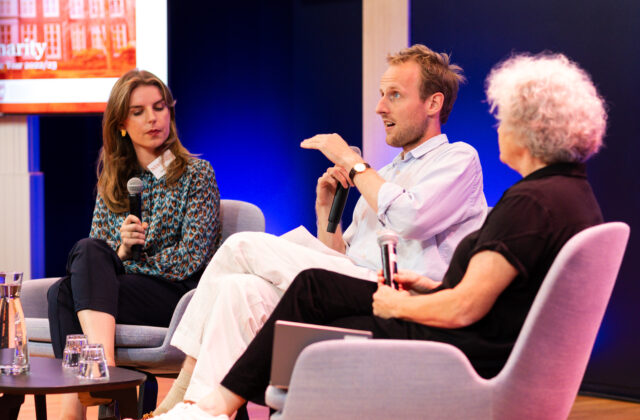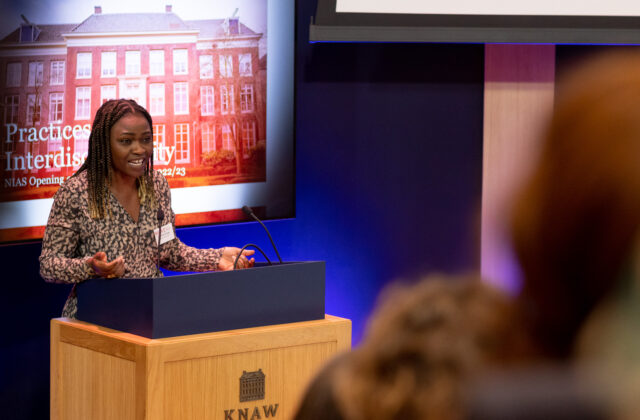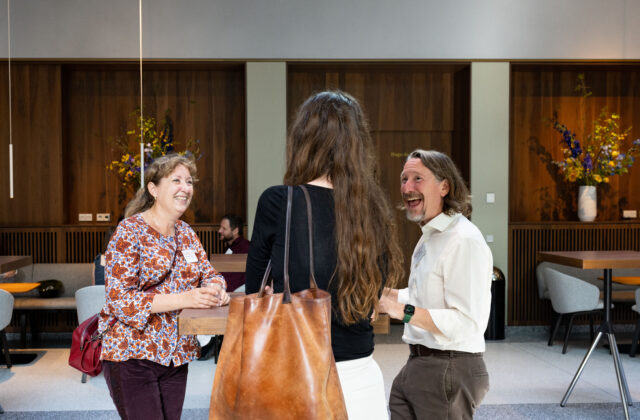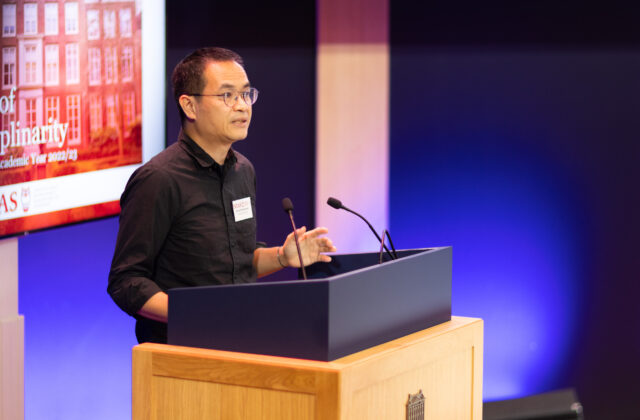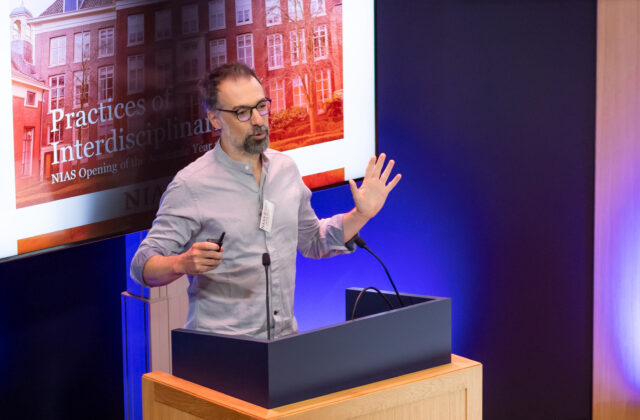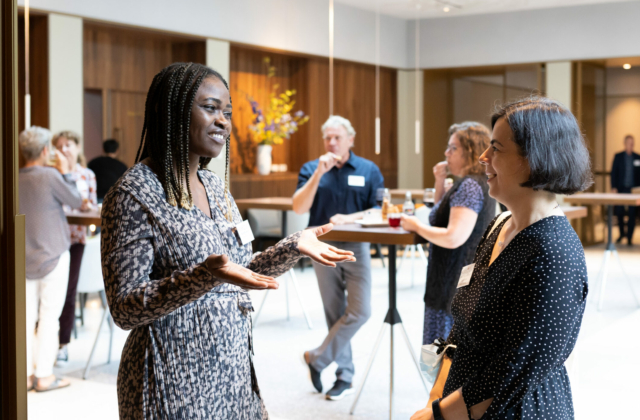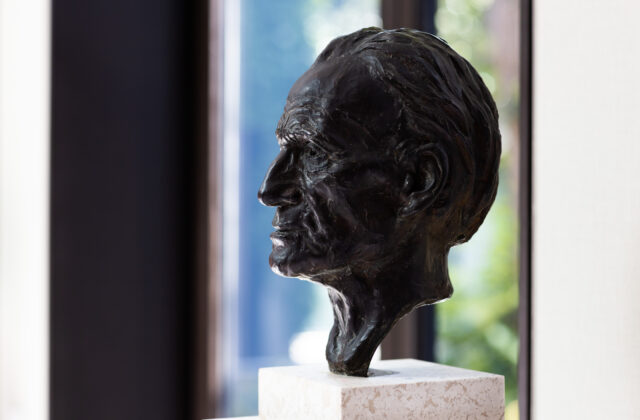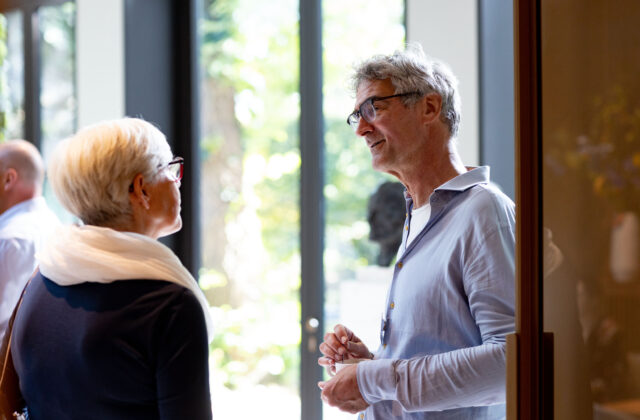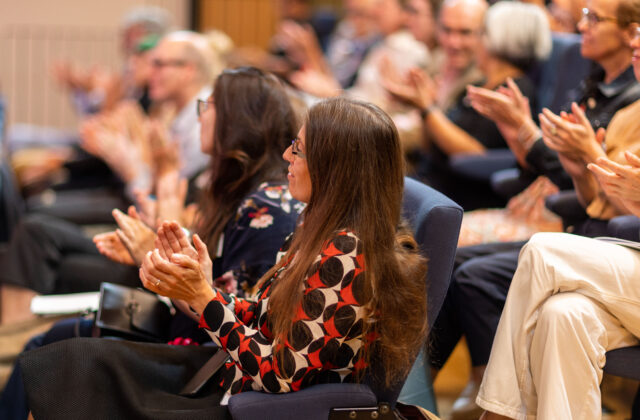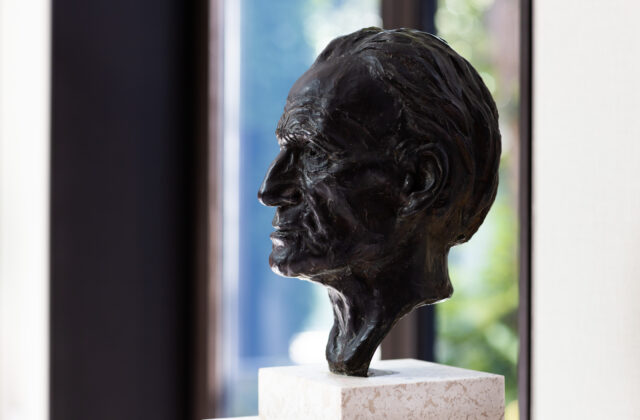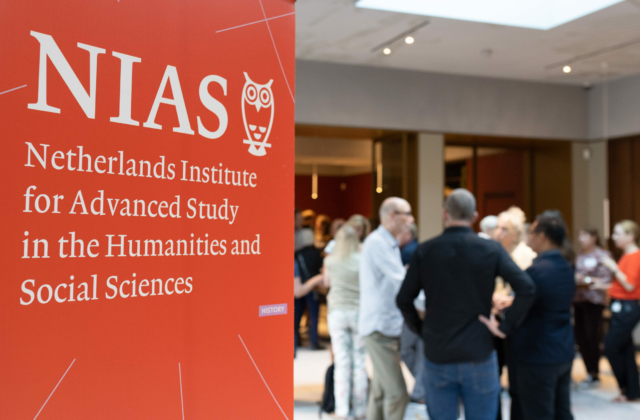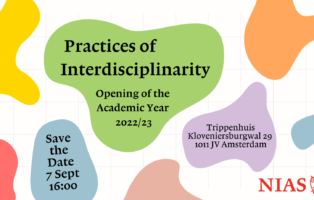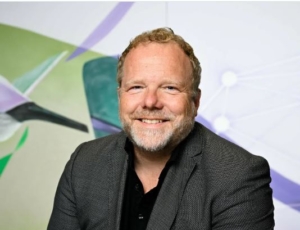It is one thing to ask what interdisciplinarity is, in the abstract. It is quite another to ask how and when it works, in and for the world around us. The theme of the NIAS Opening of the Academic year 2022-2023 ‘Practices of Interdisciplinarity’ – was chosen to celebrate NIAS’s rich past in creating a vibrant, curiosity-driven interdisciplinary environment as well as to highlight its ongoing critical engagement with interdisciplinarity itself.
After a word of welcome by Zará Kars, the meeting – held in the Trippenzaal – was opened by Marileen Dogterom, the newly-appointed President of the KNAW. Dogterom reflected on her first visit to NIAS, in early September, and praised it for having created such a tranquil, stimulating environment in the midst of busy Amsterdam. She also reminded all present of the KNAW’s own, unique multidisciplinary structure, bringing together scholars from all disciplines, carrying responsibility for ten research institutes across the beta–alfa–gamma divide, and being itself organized around four domains: Social Sciences, Humanities, Medical Sciences, and the Natural and Technical Sciences. Dogterom, whose background is in the natural sciences, shared some of her experiences with interdisciplinary research, having set up an interdisciplinary research group of exact scientists herself in the 1990s. Pointing to a crucial condition for putting interdisciplinarity into practice, Dogterom recalled discussions with funding agencies over the disciplinary boundaries of her work. If, as a physicist, she was interested in solving biological problems, how would this advance the field of physics? The reality she faced was that, depending on the label of the funding scheme, she had to argue in different ways. But obviously, the living cells that she was studying cared very little about these all-too-human divisions.
As is so often the case, the world is what happens in the spaces between disciplines…
Director of NIAS Jan Willem Duyvendak started his opening speech by insisting on the importance of reflecting on the promises and pitfalls of interdisciplinarity, especially now that it has become such a buzzword. What is the buzz all about? Is interdisciplinarity demanded only because it has become necessary to obtain grants or – as funding agencies tend to emphasize – because it is instrumentally needed to solve certain problems? Or is there actually something intrinsically good and valuable about it? Duyvendak addressed these and other questions, which ran as a red thread through the other contributions, by reflecting on NIAS’s past and present. NIAS was ‘doing’ interdisciplinarity at a time when academia was structured entirely around mono-disciplines. Indeed, institutes for advanced study like NIAS were for a long unique for this very reason, especially when compared to universities. Today, this is no longer the case: interdisciplinarity is everywhere, and almost everyone is, to a greater or lesser extent, an interdisciplinarian. The change is striking, as in many other respects the differences between NIAS, on the one hand, and Dutch academia, on the other hand, has increased in recent years. This arguably raises an important question for further study and debate: are universities putting the kind of values that NIAS promotes – curiosity, open-endedness, collaborative learning, academic freedom – at risk by jumping on the bandwagon of interdisciplinarity? It also goes to show, as Duyvendak emphasized, that interdisciplinarity is not one thing. It means different things in different contexts, it is more or less fruitful depending on what is at stake, and its definition shifts as the boundaries between individual disciplines blur.
Yesterday’s interdisciplinarity – think of historians working with big data – is today’s disciplinarity – where most historians are trained to use digital humanities tools. And vice versa: yesterday’s disciplinarity – think of the climate as a specialized topic in the natural sciences – is today’s interdisciplinarity – due, for instance, to the rise of the environmental humanities.
Duyvendak ended his talk with a topic taken up by Tamar de Waal and myself in an interview conducted and moderated by Bernike Pasveer, NIAS’s interim Head of Academic Affairs. Is interdisciplinarity unavoidable in light of today’s major, societal and academic, challenges? And if so, in what sense is it also unavoidable for NIAS to pursue it, especially given that ‘how to make interdisciplinarity work?’ is still very much an open question. But before these hard, and somewhat critical, issues were addressed, Antal van den Bosch – former Director of the Meertens Institute – offered uplifting reflections on interdisciplinarity, based partly on his own research as a linguist and computer scientist. Van den Bosch pointed to language as a shared medium and common ground, and more specifically to the creation of programming languages as a ‘completely non-messy way of communication’. Indeed, the computer – or, more specifically, computation – seems particularly fertile for interdisciplinary research across the science-humanities divide, and van den Bosch called upon everyone to find such a common, formal ground for collaboration.
Tamar and myself, both coming from the humanities, focused more on the complexities of doing interdisciplinarity at NIAS. I began by presenting NIAS as a three-sided institute: it is multidisciplinary with an interdisciplinary ambition and a transdisciplinary conscious. If this is, indeed, what NIAS is, as Tamar rightly reminded us, it does its job very well. And precisely because interdisciplinarity is such a buzzword, perhaps it is best if NIAS continues to focus on offering a safe haven for disciplinarians to work on slow science among other disciplinarians. I myself was eager to invite NIAS to be more ambitious – not by jumping on the bandwagon of interdisciplinarity, but by promoting what is lacking in Dutch academia today: critical, interdisciplinary debate and reflection on interdisciplinarity, informed by insights from the field (!) called interdisciplinary studies. It was here that our positions intersected: we both feel that it is crucial for the humanities and social sciences to become aware of what is at stake in the interdisciplinary turn, and to ask, for instance, what exactly is in it for them. What is their role within large-scale interdisciplinary consortia? What are the assumptions behind the wide-spread idea that today’s societal challenges can only be met through interdisciplinary collaboration? Which disciplines are shaping our increasingly interdisciplinary agendas? If there is one institute that can foster critical engagement with these questions, it is NIAS.
The next speaker was Arjen Doelman, Director of the Lorentz Center – a NIAS partner for over 10 years. Like van den Bosch, Doelman offered uplifting examples of successful interdisciplinary practices, in this case of NIAS-Lorentz workshops, from ‘Geometric Patterns in Islamic Art’ (2006) to ‘Othering and Polarization’ (2022). The central message was that the importance of interdisciplinarity has not really changed, but only the kind of importance that is attached to it and the way in which it is being put into practice – namely, less top-down and more bottom-up. Some ten or twenty years ago, interdisciplinarity was only on the minds of eminent disciplinarians who became convinced that they needed to collaborate with scholars from other disciplines. Today, the younger generation cares very little about disciplinary boundaries; they want to do something for the planet, say, and do so by combining insights from different disciplines. All in all, as Doelman cited from a recent get-together on interdisciplinarity: ‘have confidence in the resilience of the system’ – or, that is, interdisciplinarity, given its importance, will drive itself.
Next, Zara Kars introduced the second part of the meeting, where new NIAS fellows shared their personal reflections on the theme in short talks.
First up was the poet, painter and curator Michael Tedja – Writer-in-Residence 2022/23 – who at NIAS will work on his new novel, ‘Dat is dat ding’ (‘That is that thing’). Tedja read a translation of an essay published earlier in the summer in Dutch newspaper NRC.[1] His rich and forceful point was that we need policies aimed at promoting the arts and not political (or, that is, politicized art) agendas which, for instance, ‘lump together black artists as if they are not individuals’. The second speaker was Abosede George, Associate Professor of History at Barnard College and Columbia University, who took the opportunity to highlight the work of LSA, the Lagos Studies Association. A highly self-reflective platform, the LSA emerged from conversations with scholars from Lagos, Nigeria about the challenges they faced in being present at such meetings in the US. In doing so, George pointed to the crucial fact that for interdisciplinarity to happen certain, sometimes very tangible, conditions need to be met. For instance, interdisciplinary gatherings need to be accessible to and safe for everyone, and – in bringing together academics, artists, journalists, policy-makers and activists – they should accommodate different styles and traditions of communicating knowledge.
Davide Grossi, Associate Professor in Multi-Agent Decision-Making at the University of Groningen and the University of Amsterdam, picked up on the topic of interdisciplinarity as not always being a rosy endeavor. He reflected on his own collaborations as a computer scientist with economists, social scientists and legal scholars. To fit together all disciplinary pieces into a bigger picture for everyone to see requires dealing with frustration and mutual misunderstanding and the cultivation of trust. This line of thinking was continued by the fourth and fifth speakers, Sonny Mumbunan, Lead Environmental Economist at the World Resources Institute in Indonesia, and Anniek de Ruiter, Founding Director of the Law Center for Health and Life at the University of Amsterdam. Mumbunan put the focus on one of the central issues of the field of interdisciplinary studies: making interdisciplinarity possible and work asks of scholars to be able to become aware of their own perspective and, thereby, to open up to that of others. This, as Mumbanan emphasized, is often very difficult to achieve. De Ruiter, who like Rossi presented interdisciplinarity as a puzzle, offered one reason why: academia (institutes, journals, career paths) is still structured, to a significant extent, around individual disciplines which, of course, is strikingly at odds with all the efforts put into and importance attached to interdisciplinarity. Susanna Sreedhar – Professor of Philosophy at Boston University who will join NIAS in 2023 as part of Theme Group – drew attention to one other key element of interdisciplinarity, one difficult to pin down or put in place: serendipity and surprise.
Interestingly, in praising interdisciplinarity, many NIAS fellows pointed to its conditions and, hence, to its limits. After all, if so many conditions have to be met in order to let interdisciplinarity happen and flourish, isn’t it clear that there are limits to what can be expected from it? If interdisciplinarity is today seen as unavoidable and necessary, what to make of and how to deal with its rather elusive nature? Rather than only offering answers to some of our most urgent questions, interdisciplinarity itself remains an open question. Indeed, it would not go too far to say that, instead of only promoting it for purely instrumental reasons, it should also be promoted as a problem in itself – a problem that is not there to be solved, but to be embraced and engaged with, reflected and acted upon, if only to understand what it has to tell us about why and how we pursue knowledge in our 21st-century world. As ‘Practices of Interdisciplinarity’ showed, NIAS is very well suited to pioneer this new approach, aimed at a better, richer and more critical interdisciplinarity by and for the humanities and social sciences.
[1] See here: Opinie | Maak beleid voor de schone kunsten en niet voor politieke kunstagenda’s – NRC
NIAS Opening of the Academic Year 2022/23
